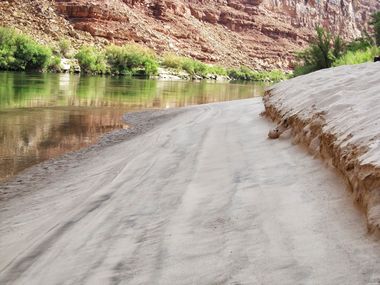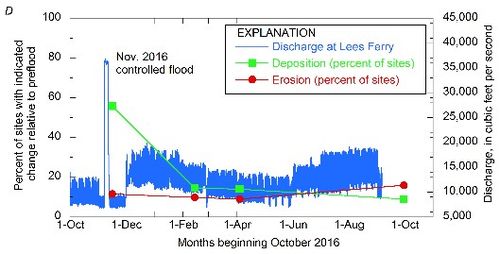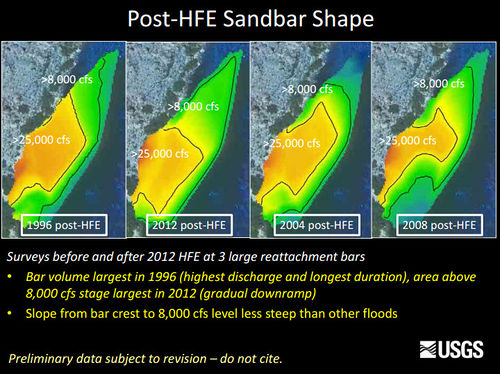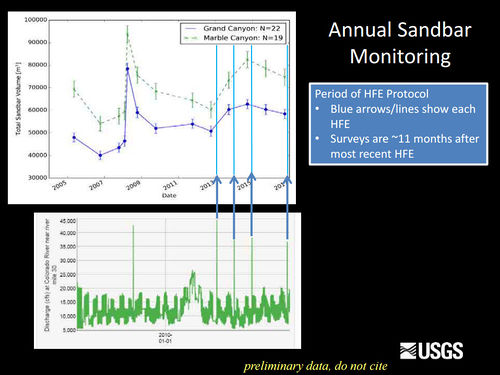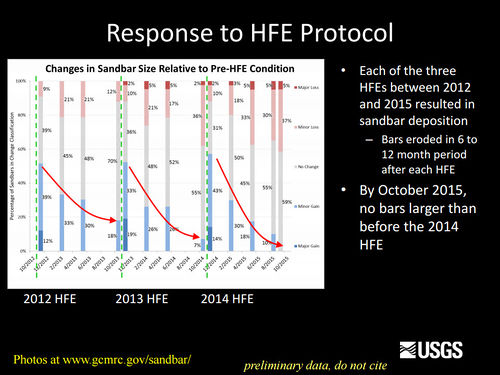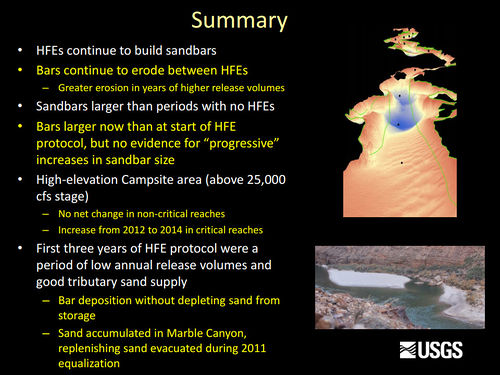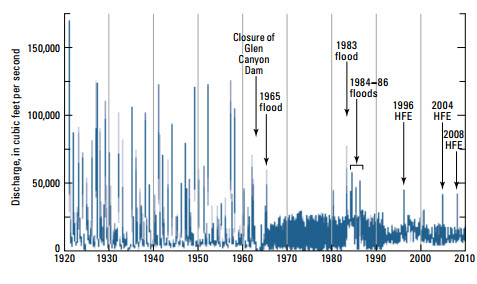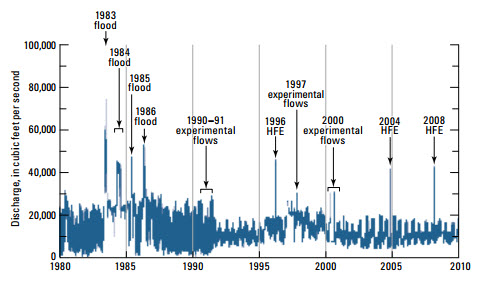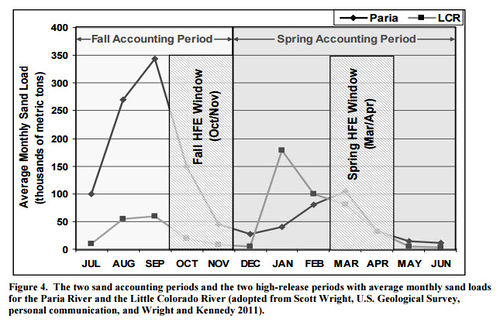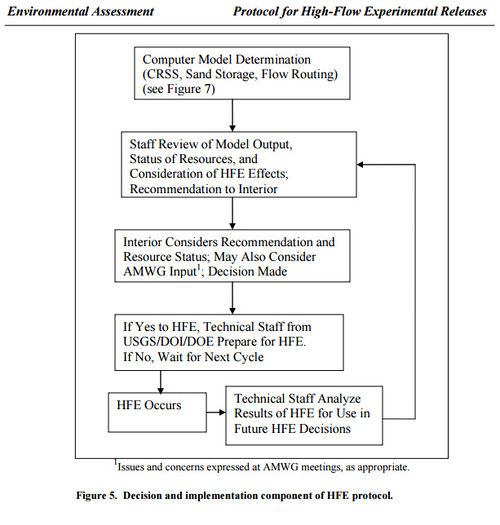Difference between revisions of "The HFE Page"
Cellsworth (Talk | contribs) |
Cellsworth (Talk | contribs) |
||
| (129 intermediate revisions by the same user not shown) | |||
| Line 27: | Line 27: | ||
=='''High-Flow Experimental (HFE) Releases'''== | =='''High-Flow Experimental (HFE) Releases'''== | ||
| − | |||
| − | + | ===Purpose and Goal=== | |
| + | The purpose of HFEs is to determine if sandbar building during HFEs exceeds sandbar erosion during periods between HFEs, such that sandbar size can be increased or maintained over several years. | ||
| + | |||
| + | ===LTEMP HFE Protocol=== | ||
| + | As described in the LTEMP ROD, HFEs are experimental in nature and are designed to achieve a better understanding of whether, how, and when to incorporate high releases into future dam operations in a manner that maintains or improves beaches, sandbars, and associated habitat. The LTEMP HFE Protocol establishes a decision-making framework consisting of three components: (1) planning and budgeting, (2) modeling, and (3) decision and implementation. | ||
| + | |||
| + | Under the LTEMP, HFE releases are restricted to limited periods of the year when the highest volumes of sediment are most likely available for building sandbars. Sediment-triggered HFEs may be made in spring (March or April) or fall (October or November; Figure 1). Fall extended-duration HFEs range from greater than 96 hr to 250 hr. Spring and fall HFEs that are not extended-duration range from less than 1 hr to 96 hr. Proactive HFEs may be implemented in spring or early summer (April, May or June), and have a duration range up to 24 hr. HFE magnitudes range from 31,500 cubic feet per second (cfs) to 45,000 cfs. The frequency of HFEs is determined by tributary sediment inputs, annual release volumes, resource conditions, and decisions of the Department. Extended-duration fall HFEs are limited to a frequency of 4 times total in the 20-year LTEMP period. | ||
| + | |||
| + | ===HFE Sand Budget Model=== | ||
| + | The LTEMP HFE Protocol uses predictive models to make recommendations for the magnitude and duration of potential HFEs using real-time measurements and models of sand inflow from the Paria River and forecasted hydrologic data to determine whether suitable sediment and hydrology conditions exist for a high-flow experimental release. | ||
| + | |||
| + | A sand transport/budget model (Wright et al. 2010) was used to predict the mass of sand that would be transported by an HFE and to estimate if a proposed HFE would transport more or less sand than had been delivered from the Paria River to the Colorado River during the fall accounting period (July 1 to November 30). Only HFE durations that resulted in a “positive sand balance” were considered. Output of the modeling runs provides the initial recommendation for the magnitude and duration of the HFE. However, because modeling only considers a simple range of possible HFE peak magnitudes and durations, the Protocol includes a review of the model output that may modify the recommended HFE to benefit relevant resources. (2018 HFE Tech Team Report) | ||
| − | |||
|}<!-- | |}<!-- | ||
| Line 44: | Line 53: | ||
|class="MainPageBG" style="width:55%; border:1px solid #cef2e0; background:#f5faff; vertical-align:top; color:#000;"| | |class="MainPageBG" style="width:55%; border:1px solid #cef2e0; background:#f5faff; vertical-align:top; color:#000;"| | ||
{|width="100%" cellpadding="2" cellspacing="5" style="vertical-align:top; background:#f5faff;" | {|width="100%" cellpadding="2" cellspacing="5" style="vertical-align:top; background:#f5faff;" | ||
| − | ! <h2 style="margin:0; background:#cedff2; font-size:120%; font-weight:bold; border:1px solid #a3bfb1; text-align:left; color:#000; padding:0.2em 0.4em;">Updates</h2> | + | ! <h2 style="margin:0; background:#cedff2; font-size:120%; font-weight:bold; border:1px solid #a3bfb1; text-align:left; color:#000; padding:0.2em 0.4em;"> Updates </h2> |
|- | |- | ||
|style="color:#000;"| | |style="color:#000;"| | ||
| − | [[File: | + | [[File:SandbarVolume2018.jpg|center|thumbnail|500px| Sandbar volume 1990-2018]] |
| − | [[File: | + | [[File:PostHFEerosion.jpg|center|thumbnail|500px|Rate of post-HFE beach erosion]] |
| − | [[File:HFE decision tree.jpg|center| | + | [[File:HFE_size_shape.jpg|center|thumbnail|500px|[https://www.usbr.gov/uc/progact/amp/twg/2017-01-26-twg-meeting/AR3_Grams.pdf https://www.usbr.gov/uc/progact/amp/twg/2017-01-26-twg-meeting/AR3_Grams.pdf]]] |
| + | |||
| + | [[File:SandbarMonitoring2016.jpg|thumbnail|center|500px|[https://www.usbr.gov/uc/progact/amp/twg/2017-01-26-twg-meeting/AR3_Grams.pdf https://www.usbr.gov/uc/progact/amp/twg/2017-01-26-twg-meeting/AR3_Grams.pdf]]] | ||
| + | |||
| + | [[File:2012 2014 HFE response.jpg|thumbnail|center|500px|[https://www.usbr.gov/uc/progact/amp/twg/2015-06-11-twg-meeting/Attach_02,.pdf https://www.usbr.gov/uc/progact/amp/twg/2015-06-11-twg-meeting/Attach_02,.pdf]]] | ||
| + | |||
| + | [[File:2016 SedimentSummary.jpg|thumbnail|center|500px|[https://www.usbr.gov/uc/progact/amp/twg/2016-02-26-twg-meeting/AR02_Grams.pdf https://www.usbr.gov/uc/progact/amp/twg/2016-02-26-twg-meeting/AR02_Grams.pdf]]] | ||
| + | |||
| + | [[File:GCDFlowRecord.jpg|center|px500]] | ||
| + | |||
| + | [[File:GCDExperimentalFlows.jpg|center|px500]] | ||
| + | |||
| + | |- | ||
| + | ! <h2 style="margin:0; background:#cedff2; font-size:120%; font-weight:bold; border:1px solid #a3b0bf; text-align:left; color:#000; padding:0.2em 0.4em;"> [https://gcdamp.com/index.php/Long-term_Experimental_and_Management_Plan_(LTEMP) 2024 LTEMP SEIS] </h2> | ||
| + | |- | ||
| + | |style="color:#000;"| | ||
| + | |||
| + | The [https://gcdamp.com/images_gcdamp_com/d/db/20240500-GCDLTEMP-FinalSEIS-508-AMWD_%282%29.pdf 2024 LTEMP SEIS] adjusted the semiannual sediment accounting period to an annual period (beginning July 1) with the option for a spring or fall HFE release, or both. If a sediment trigger is met, but an HFE release is not implemented in the fall or spring, rollover of sediment into the next accounting period is possible. Implementation of a fall HFE can occur in October or November. Spring implementation could occur from March through June, depending on resource conditions and the potential for implementation of the 2024 LTEMP SEIS cold-water alternatives that include flow spikes. [https://www.usbr.gov/uc/DocLibrary/EnvironmentalImpactStatements/GlenCanyonDamLong-TermExperimentalManagementPlan/20240703-GCDLTEMP-FinalSEIS-RecordofDecision-508-AMWD.pdf] | ||
| + | |||
| + | |- | ||
| + | ! <h2 style="margin:0; background:#cedff2; font-size:120%; font-weight:bold; border:1px solid #a3b0bf; text-align:left; color:#000; padding:0.2em 0.4em;"> LTEMP Experimental Action: Sediment-Related Experimental Treatments (Table 2-2, pages 11-12) [https://ltempeis.anl.gov/documents/final-eis/vol1/Chapter_2-Alternatives.pdf] </h2> | ||
| + | |- | ||
| + | |style="color:#000;"| | ||
| + | |||
| + | Under Alternative D, the existing HFE protocol was updated and incorporated into the LTEMP process as specified in Appendix P of the FEIS. Changes to the existing protocol were related to implementation of the new HFEs that are included under Alternative D and an B-17 extension of the protocol to the end of the LTEMP period. This new protocol will replace the existing protocol when the LTEMP ROD is issued. Spring and fall HFEs will be implemented when triggered during the 20-year LTEMP period based on the estimated sand mass balance resulting from Paria River sediment inputs during the spring and fall accounting periods, and the dam release pattern during the accounting period. HFE releases will be 1 to 250 hr long and between 31,500 cfs and 45,000 cfs. Depending on the cumulative amount of sediment input from the Paria River during the spring (December 1 through June 30) or fall (July 1 through November 30) accounting periods and the expected accumulation of sand, the maximum possible magnitude and duration of HFE that would achieve a positive sand mass balance in Marble Canyon, as determined by modeling, will be implemented. | ||
| + | |||
| + | Sand mass balance modeling will be used to ensure that the duration and magnitude of an HFE are best matched with the mass of sand present in the system during a particular release window. The magnitude and duration of HFEs will not affect the total annual release from Glen Canyon Dam. Reclamation will consider the total water to be released in the water year when determining the magnitude and duration of an HFE. [https://ltempeis.anl.gov/documents/docs/LTEMP_ROD.pdf] | ||
| + | |||
| + | '''Sediment-Triggered Spring HFEs''' | ||
| + | *HFE window: Mar-Apr | ||
| + | *Up to 96 hrs | ||
| + | *Could begin after the first two years of LTEMP (start spring 2020), | ||
| + | *Not in the same water year as an extended-duration (>96 hr) fall HFE | ||
| + | |||
| + | '''Proactive Spring HFEs''' | ||
| + | *Triggered by an annual release volume over 10.0 maf | ||
| + | *HFE window: Apr-Jun | ||
| + | *Up to 24 hrs | ||
| + | *Not in the same water year as a sediment-triggered spring HFE or an extended-duration (>96 hr) fall HFE | ||
| + | |||
| + | '''Sediment-Triggered Fall HFEs''' | ||
| + | *HFE window: Oct-Nov | ||
| + | *Up to 96 hrs | ||
| + | |||
| + | '''Extended-Duration Fall HFEs''' | ||
| + | *HFE window: Oct-Nov | ||
| + | *Up to 250 hrs | ||
| + | *The first test would be limited to 192 hrs | ||
| + | *No more than four during the 20-year LTEMP period | ||
| + | |||
| + | [[File:HFE windows.jpg|center|500px]] | ||
| + | |||
| + | [[File:HFE types.JPG|center|700px]] | ||
| + | |||
| + | [[File:HFE decision tree.jpg|center|500px]] | ||
| + | |||
| + | |- | ||
| + | ! <h2 style="margin:0; background:#cedff2; font-size:120%; font-weight:bold; border:1px solid #a3b0bf; text-align:left; color:#000; padding:0.2em 0.4em;">The Planning and Implementation (P&I) Process</h2> | ||
| + | |- | ||
| + | |style="color:#000;"| | ||
| + | |||
| + | 1.4 COMMUNICATION AND CONSULTATION PROCESS FOR ALTERNATIVE D | ||
| + | |||
| + | To determine whether conditions are suitable for implementing or discontinuing experimental treatments or management actions, the DOI will schedule implementation/planning meetings or calls with the DOI bureaus (USGS, NPS, FWS, BIA, and Reclamation), WAPA, AZGFD, and one liaison from each Basin State and from the UCRC, as needed or requested by the participants. The implementation/planning group will strive to develop a consensus recommendation to bring forth to the DOI regarding resource issues as detailed at the beginning of this section, as well as including WAPA’s assessment of the status of the Basin Fund. The Secretary of the Interior will consider the consensus recommendations of the implementation/planning group, but retains sole discretion to decide how best to accomplish operations and experiments in any given year pursuant to the ROD and other binding obligations. (B-17 in the LTEMP ROD) | ||
|} | |} | ||
| Line 62: | Line 134: | ||
|class="MainPageBG" style="width:45%; border:1px solid #cedff2; background:#f5faff; vertical-align:top;"| | |class="MainPageBG" style="width:45%; border:1px solid #cedff2; background:#f5faff; vertical-align:top;"| | ||
{| width="100%" cellpadding="2" cellspacing="5" style="vertical-align:top; background:#f5faff;" | {| width="100%" cellpadding="2" cellspacing="5" style="vertical-align:top; background:#f5faff;" | ||
| − | ! <h2 style="margin:0; background:#cedff2; font-size:120%; font-weight:bold; border:1px solid #a3b0bf; text-align:left; color:#000; padding:0.2em 0.4em;"> | + | ! <h2 style="margin:0; background:#cedff2; font-size:120%; font-weight:bold; border:1px solid #a3b0bf; text-align:left; color:#000; padding:0.2em 0.4em;">Links and Information</h2> |
|- | |- | ||
|style="color:#000;"| | |style="color:#000;"| | ||
| − | |||
*[http://www.usbr.gov/uc/rm/gcdHFE/ USBR HFE Page] | *[http://www.usbr.gov/uc/rm/gcdHFE/ USBR HFE Page] | ||
| − | *[http://www.usbr.gov/uc/envdocs/ea/gc/HFEProtocol/index. | + | *[https://www.usgs.gov/centers/sbsc/science/high-flow-experiments-colorado-river?qt-science_center_objects=0#qt-science_center_objects GCMRC HFE Page] |
| − | *[[Sediment Mass Balance for HFE | + | *[[GCDAMP Sediment| The Sediment Page]] |
| + | *[https://www.usbr.gov/uc/progact/amp/amwg/2023-08-17-amwg-meeting/20230817-ProposalAmendHigh-FlowExperimentProtocolOtherConsiderations-508-UCRO.pdf 2023 Proposal to Amend the High-Flow Experiment Protocol and Other Considerations ] | ||
| + | *[http://www.usbr.gov/uc/envdocs/ea/gc/HFEProtocol/ Environmental Assessment for the Development and Implementation of a Protocol for High-flow Experimental Releases from Glen Canyon Dam, Arizona, 2011 - 2020] | ||
| + | *[https://www.usbr.gov/uc/DocLibrary/Memos/20240326-EstablishmentInterimOperatingGuidanceGlenCanyonDamLowReservoirLevels-TechnicalDecisionMemo-508-TSC.pdf Technical Decision Memo: Establishment of Interim Operating Guidance for Glen Canyon Dam during Low Reservoir Levels at Lake Powell ] | ||
| + | *Fall HFEs may be connected to the recent increase in [http://gcdamp.com/index.php?title=Brown_Trout brown trout] at Lees Ferry. | ||
| + | *Spring HFEs increase productivity of the [http://gcdamp.com/index.php?title=FOOD_BASE aquatic foodbase]. Fall HFEs do not appear to affect the long-term composition of the [http://gcdamp.com/index.php?title=FOOD_BASE aquatic foodbase] and may scour the foodbase prior to the winter non-growing season. | ||
| + | *HFEs do not appear to directly affect [http://gcdamp.com/index.php?title=Humpback_Chub_Page humpback chub] or the [http://gcdamp.com/index.php?title=FISHERY rainbow trout fishery] but there may be indirect affects tied to foodbase and trout production. | ||
| + | *[[Sediment Mass Balance for HFE considerations- Model explanation| Sediment Mass Balance for HFE considerations- Model explanation]] | ||
*[[GCDAMP Rapid Response Learning Page| Rapid Response HFE Page]] | *[[GCDAMP Rapid Response Learning Page| Rapid Response HFE Page]] | ||
| + | |||
| + | |- | ||
| + | ! <h2 style="margin:0; background:#cedff2; font-size:120%; font-weight:bold; border:1px solid #a3b0bf; text-align:left; color:#000; padding:0.2em 0.4em;">Glen Canyon Dam Flow Experiments</h2> | ||
| + | |- | ||
| + | |style="color:#000;"| | ||
| + | *A 2023 Fall HFE was not conducted for lack of sediment | ||
| + | *[[The 2023 Spring HFE| The 2023 Spring HFE]] | ||
| + | *[[A 2022 Fall HFE| A 2022 Fall HFE]] was not conducted due to the discovery of [http://gcdamp.com/index.php/Smallmouth_Bass_Page smallmouth bass] in Glen Canyon (1,600,000 mt) | ||
| + | *[[A 2022 Spring HFE| A 2022 Spring HFE]] was not conducted for lack of sediment | ||
| + | *[[A 2021 Fall HFE| A 2021 Fall HFE]] was not conducted due to low reservoir elevations (1,492,000 mt) | ||
| + | *[[A 2021 Spring HFE| A 2021 Spring HFE]] was not conducted for lack of sediment | ||
| + | *[http://gcdamp.com/index.php?title=Spring_Disturbance_Flow The 2021 Spring Disturbance Flow] | ||
| + | *[[The 2020 Fall HFE| A 2020 Fall HFE]] was not conducted for lack of sediment | ||
| + | *[[The 2020 Spring HFE| A 2020 Spring HFE]] was not conducted for lack of sediment | ||
| + | *[[The 2019 Fall HFE| A 2019 Fall HFE]] was not conducted for lack of sediment | ||
| + | *[[The 2018 Fall HFE]] (60h) | ||
| + | *[[The 2017 Fall HFE| A 2017 Fall HFE]] was not conducted for lack of sediment | ||
| + | *[http://gcdamp.com/index.php?title=GCDAMP-_HFE_2016 The 2016 Fall HFE] | ||
| + | *[http://gcdamp.com/index.php?title=GCDAMP-_HFE_2015 A 2015 Fall HFE] was canceled due to the discovery of [http://gcdamp.com/index.php?title=Green_Sunfish_Page green sunfish] in Glen Canyon | ||
| + | *[http://gcdamp.com/index.php?title=GCDAMP-_HFE_2014 The 2014 Fall HFE] (1,213,000 mt) | ||
| + | *[http://gcdamp.com/index.php?title=GCDAMP-_HFE_2013 The 2013 Fall HFE] (1,860,000 mt) | ||
| + | *[http://gcdamp.com/index.php?title=GCDAMP-_HFE_2012 The 2012 Fall HFE] (slow downramp) | ||
| + | *The 2011 Equalization flows | ||
| + | *[http://gcdamp.com/index.php?title=Near_Shore_Ecology_(NSE)_Study The 2009-11 Fall Steady Flow Experiment] | ||
| + | *[http://digitalcommons.usu.edu/cgi/viewcontent.cgi?article=1153&context=govdocs The 2008 Spring HFE] | ||
| + | *[https://pubs.usgs.gov/fs/2011/3012/ The 2004 Fall HFE] | ||
| + | *[[The 2000 Low Summer Steady Flow Experiment| The 2000 Low Steady Summer Flow Experiment (LSSF)]] | ||
| + | *The 1997 Experimental Flows | ||
| + | *[[The 1996 Spring HFE]] | ||
| + | *The 1990-91 Experimental Flows | ||
| + | *[http://www.riversimulator.org/Resources/GCDAMP/GCDAMPchronicle/1983FloodGCDhannon.pdf The 1983-86 Floods] | ||
| + | *[[The 1965 Reservoir Equalization and Channel Cleaning Floods]] | ||
|- | |- | ||
| Line 75: | Line 185: | ||
|- | |- | ||
|style="color:#000;"| | |style="color:#000;"| | ||
| + | |||
| + | '''2023''' | ||
| + | *[https://www.usbr.gov/uc/progact/amp/twg/2023-11-08-twg-meeting/20231108-HFEProtocolFall2023-508-UCRO.pdf HFE Protocol for Fall 2023] | ||
| + | *[https://www.usbr.gov/uc/progact/amp/amwg/2023-08-17-amwg-meeting/20230817-TWGHFEProtocolMotion-508-UCRO.pdf TWG HFE Protocol Motion] | ||
| + | *[https://www.usbr.gov/uc/progact/amp/amwg/2023-08-17-amwg-meeting/20230817-April2023High-FlowExperimentPreliminaryResults-508-UCRO.pdf April 2023 High-Flow Experiment (HFE) Preliminary Results] | ||
| + | *[https://www.usbr.gov/uc/progact/amp/amwg/2023-08-17-amwg-meeting/20230817-BackgroundInformationProposalAmendHigh-FlowExperimentProtocol-508-UCRO.pdf Background Information for "Proposal to Amend the High-Flow Experiment (HFE) Protocol"] | ||
| + | *[https://www.usbr.gov/uc/progact/amp/amwg/2023-08-17-amwg-meeting/20230817-PreliminaryFieldReportAprilHigh-FlowExperiment-508-UCRO.pdf Preliminary Field Report from the April High-Flow Experiment] | ||
| + | *[https://www.usbr.gov/uc/progact/amp/amwg/2023-08-17-amwg-meeting/20230817-ProposalAmendHigh-FlowExperimentProtocolOtherConsiderations-508-UCRO.pdf Proposal to Amend the High-Flow Experiment Protocol and Other Considerations] | ||
| + | *[https://www.usbr.gov/uc/progact/amp/amwg/2023-08-17-amwg-meeting/20230817-ProposalAmendHigh-FlowExperimentProtocolOtherConsiderations-508-UCRO.pdf Proposal to Amend the High-Flow Experiment Protocol and Other Considerations] | ||
| + | *[https://www.usbr.gov/uc/progact/amp/twg/2023-06-15-twg-meeting/20230615-April2023HighFlowExperimentPreliminarySandbarResults-508-UCRO.pdf April 2023 High-Flow Experiment Preliminary Sandbar Results] | ||
| + | *[https://www.usbr.gov/uc/progact/amp/twg/2023-06-15-twg-meeting/20230615-PreliminaryFieldReportsAprilHighFlowExperiment-508-UCRO.pdf Preliminary Field Reports from the April High-Flow Experiment ] | ||
| + | *[https://www.usbr.gov/uc/progact/amp/twg/2023-04-13-twg-meeting/20230413-ChargeCreateProcessAmendHFEProtocol-508-UCRO.pdf Charge to create a process to amend the HFE protocol] | ||
| + | *[https://www.usbr.gov/uc/progact/amp/amwg/2023-02-16-amwg-meeting/20230216-OverviewProjectsABLEvaluationHigh-FlowExperimentsDuringAridification-508-UCRO.pdf Overview of Projects A, B, and L and Evaluation of High-Flow Experiments During Aridification] | ||
| + | *[https://www.usbr.gov/uc/progact/amp/twg/2023-01-26-twg-meeting/20230126-AnnualReportingMeeting-OverviewEvaluationHigh-FlowExperimentsDuringAridification-508-UCRO.pdf Project B Overview and Evaluation of High-Flow Experiments During Aridification] | ||
| + | |||
| + | '''2022''' | ||
| + | *[[Media:Grams_HFE_discussion_20220901.pdf| Evaluation of High-Flow Experiments under conditions of low flows and low reservoir elevations]] | ||
| + | *[https://www.usbr.gov/uc/progact/amp/twg/2022-01-13-twg-meeting/20220113-AnnualReportingMeeting-EffectsHigh-flowExperimentsDamReleasesSandbarErosionDepositionMarbleGrandCanyons-508-UCRO.pdf The Effects of High-flow Experiments and Dam Releases on Sandbar Erosion and Deposition in Marble and Grand Canyons ] | ||
| + | |||
| + | '''2021''' | ||
| + | *[[Media:Grams 2021 Geomorphic.pdf| Mueller and Grams, 2021, A morphodynamic model to evaluate long‐term sandbar rebuilding using controlled floods in the Grand Canyon: Geophysical Research Letters]] | ||
| + | |||
| + | '''2020''' | ||
| + | *[https://www.usbr.gov/uc/progact/amp/twg/2020-06-24-twg-meeting/20200624-High-FlowExperimentsSedimentModeling-508-UCRO.pdf HFE Sediment Modeling ] | ||
| + | *[https://www.usbr.gov/uc/progact/amp/twg/2020-06-24-twg-meeting/20200624-CarlisleEcoSigDimSpringFreshets.pdf Ecological Significance of Diminished Spring Freshets ] | ||
| + | *[https://www.usbr.gov/uc/progact/amp/twg/2020-06-24-twg-meeting/20200624-Grams-TWG.pdf Evaluating the Frequency of Triggered Spring High Flow Experiments Assumed in the LTEMP ] | ||
| + | *[https://www.usbr.gov/uc/progact/amp/twg/2020-01-13-twg-meeting/20200113-AnnualReportingMeeting-PotentialSpringHighFlowExperiment%E2%80%93StatusResourcesExperimentalPlan-Presentation-508-UCRO.pdf Potential Spring High Flow Experiment – Status of Resources and Experimental Plan ] | ||
| + | |||
| + | '''2019''' | ||
| + | *[https://www.usbr.gov/uc/progact/amp/twg/2019-03-14-twg-meeting/20190314-WhatsNextKeyUncertaintiesFutureHFEDesign-Presentation-508-UCRO.pdf What’s Next? Key Uncertainties and Future HFE Design Presentation ] | ||
| + | *[https://www.usbr.gov/uc/progact/amp/twg/2019-03-14-twg-meeting/20190314-TheEffectsHigh-flowExperimentsSandbarDynamics-Presentation-508-UCRO.pdf The Effects of High-flow Experiments on Sandbar Dynamics Presentation ] | ||
| + | |||
| + | '''2018''' | ||
| + | *[https://qcnr.usu.edu/wats/colorado_river_studies/files/documents/Grams.pdf Geomorphic Changes to the River Channels and Flood Plains of the Colorado River System: The Planned and Unplanned Effects of Water Development] | ||
| + | *[https://www.usbr.gov/uc/progact/amp/amwg/2018-08-22-amwg-meeting/Attach_07.pdf High Flow Experiments PPT] | ||
| + | *[https://www.usbr.gov/uc/progact/amp/twg/2018-06-25-twg-meeting/Attach_14.pdf Discussion about the High Flow Experimental Design PPT] | ||
| + | *[[Media:GCWC LTEMP Springtime HFE Comments Feb 24 2016.pdf| GCWC LTEMP comments on springtime HFEs]] | ||
| + | *[https://www.usbr.gov/uc/progact/amp/twg/2018-04-23-twg-meeting/Attach_12.pdf Evaluating the Frequency of Triggered Spring High Flow Experiments (HFEs) Assumed in the Long-Term Experimental and Management Plan PPT] | ||
| + | *[https://www.usbr.gov/uc/progact/amp/amwg/2018-02-14-amwg-meeting/Attach_12b.pdf Considerations for Seasonal Scheduling of High Flow Experiments PPT] | ||
| + | *[https://www.usbr.gov/uc/progact/amp/twg/2018-01-25-twg-meeting/AR12.pdf Effects of HFEs on Growth and Population Dynamics of Rainbow Trout in Glen Canyon and Mable Canyon PPT] | ||
| + | *[https://www.usbr.gov/uc/progact/amp/twg/2018-01-25-twg-meeting/AR03.pdf Sandbars and Sediment Storage Marble and Grand Canyons: Response to Recent High-flow Experiments and Long-term Trends PPT] | ||
| + | *[https://doi.org/10.1016/j.sedgeo.2017.11.007 Mueller et al., 2018, Variability in eddy sandbar dynamics during two decades of controlled flooding of the Colorado River in Grand Canyon: Sedimentary Geology, v. 363, p. 181-199] | ||
'''2017''' | '''2017''' | ||
| − | *[https://www.usbr.gov/uc/ | + | *[https://www.usbr.gov/uc/progact/amp/twg/2017-01-26-twg-meeting/AR3_Grams.pdf Sandbars and Sediment Storage in Marble and Grand Canyons: Response to Recent High-flow Experiments and Long-term Trends PPT] |
| + | *[https://www.usbr.gov/uc/progact/amp/twg/2017-01-26-twg-meeting/AR15_Korman.pdf Boom-and-Bust Cycles in the Population of Rainbow Trout in Glen Canyon and Effect of Fall High Flow Experiments PPT] | ||
'''2016''' | '''2016''' | ||
*[[Media:Hi Flow Beaches 2016.pdf| The Grand Canyon Private Boater’s Association’s (GCPBA) comments regarding the recently concluded High Flow Experiment releases]] | *[[Media:Hi Flow Beaches 2016.pdf| The Grand Canyon Private Boater’s Association’s (GCPBA) comments regarding the recently concluded High Flow Experiment releases]] | ||
| − | *[ | + | *[https://www.usbr.gov/uc/progact/amp/amwg/2016-08-24-amwg-meeting/Attach_11c.pdf Science Behind High Flow Experiment Planning: From Chasing Storms in the Paria River to Serving Data on the Web] |
| − | *[ | + | *[https://www.usbr.gov/uc/progact/amp/twg/2016-02-26-twg-meeting/Attach_04a.pdf Sand Trigger for High-flow Experimental Protocol] |
| − | *[ | + | *[https://www.usbr.gov/uc/progact/amp/twg/2016-02-26-twg-meeting/Attach_04b.pdf Introduction of a Motion to TWG Regarding Clarification of the High Flows Protocol for Springtime HFEs: Draft for SCAHG Consideration and Review] |
| − | + | ||
| − | + | ||
'''2014''' | '''2014''' | ||
| − | *[ | + | *[https://www.usbr.gov/uc/progact/amp/twg/2014-10-28-twg-meeting/Attach_13.pdf Modeling Long Term Effects of HFEs on Trout and HBC] |
| − | *[ | + | *[https://www.usbr.gov/uc/progact/amp/amwg/2014-08-27-amwg-meeting/Attach_10.pdf Minute 319/Pulse Flow] |
| − | *[ | + | *[https://www.usbr.gov/uc/progact/amp/twg/2014-01-30-twg-meeting/Attach_02b.pdf Update on High Flow Experiments Released from Glen Canyon Dam] |
'''2013''' | '''2013''' | ||
*[http://www.earthmagazine.org/article/releasing-flood-controversy-colorado-river Earth Magazine 2013 Releasing a flood of controversy on the Colorado River] --This article sets the basis for the HFE, provides the history of past HFEs, and discusses the issues. | *[http://www.earthmagazine.org/article/releasing-flood-controversy-colorado-river Earth Magazine 2013 Releasing a flood of controversy on the Colorado River] --This article sets the basis for the HFE, provides the history of past HFEs, and discusses the issues. | ||
| − | *[ | + | *[https://www.usbr.gov/uc/progact/amp/twg/2013-11-06-twg-meeting/Attach_02b.pdf HFE Protocol Decision Process] |
| + | *[https://www.usbr.gov/uc/progact/amp/amwg/2013-08-08-amwg-meeting/Attach_09.pdf Planning for a Fall HFE] | ||
| + | *[https://www.usbr.gov/uc/progact/amp/amwg/2013-02-20-amwg-meeting/Attach_06a.pdf High Flow Experiment Update ] | ||
| + | *[https://www.usbr.gov/uc/progact/amp/amwg/2013-02-20-amwg-meeting/Attach_06b.pdf USGS Information and Results from HFE] | ||
| + | *[https://www.usbr.gov/uc/progact/amp/twg/2013-01-24-twg-meeting/Attach_06a.pdf Lessons Learned from the First HFE Protocol] | ||
| + | *[https://www.usbr.gov/uc/progact/amp/twg/2013-01-24-twg-meeting/Attach_06b.pdf Background on HFE Releases and Assessment of Success] | ||
| + | *[https://www.usbr.gov/uc/progact/amp/twg/2013-01-24-twg-meeting/14_Schmidt.pdf Background on High Flow Experimental Releases: Implementation Strategy and Assessment of Success] | ||
| + | |||
| + | '''2012''' | ||
| + | *[https://www.usbr.gov/uc/progact/amp/twg/2012-10-24-twg-meeting/Attach_05a.pdf General Science Plan for Monitoring and Research of a High-Flow Experimental Protocol at Glen Canyon Dam White Paper Dated Dec. 22, 2011, and PPT] | ||
| + | *[https://www.usbr.gov/uc/progact/amp/twg/2012-10-24-twg-meeting/Attach_05b.pdf Update on High Flow Experiment PPT] | ||
| + | *[https://www.usbr.gov/uc/progact/amp/amwg/2012-08-29-amwg-meeting/Attach_01a.pdf News Release Dated May 23, 2012, Subj: Salazar Announces Improvements to Glen Canyon Dam Operations to Restore High Flows and Native Fish in Grand Canyon] | ||
| + | *[https://www.usbr.gov/uc/progact/amp/amwg/2012-08-29-amwg-meeting/Attach_01b.pdf Creation of DOI Leadership Team to Implement Actions Outlined in the Two Environmental Assessments] | ||
| + | *[https://www.usbr.gov/uc/progact/amp/amwg/2012-08-29-amwg-meeting/Attach_04b.pdf Implementation of the HFE Protocol with Emphasis on Fall 2012] | ||
| + | *[https://www.usbr.gov/uc/progact/amp/amwg/2012-08-29-amwg-meeting/Attach_04c.pdf High Flow Experiment Modeling Process PPT] | ||
| + | *[https://www.usbr.gov/uc/progact/amp/amwg/2012-02-22-amwg-meeting/Attach_11a.pdf Two Environmental Assessments Updates] | ||
| + | *[https://www.usbr.gov/uc/progact/amp/amwg/2012-02-22-amwg-meeting/Attach_11b.pdf High-Flow Protocol Environmental Assessment PPT] | ||
| + | *[https://www.usbr.gov/uc/progact/amp/twg/2012-02-02-twg-meeting/Attach_02.pdf Final Biological Opinion on the Operation of Glen Canyon Dam Including High Flow Experiments and Non-Native Fish Control Memo] | ||
| + | *[https://www.usbr.gov/uc/progact/amp/twg/2012-02-02-twg-meeting/Attach_05c.pdf Executive Summaries from the High-Flow Experiment EA and the Non-Native Fish Control EA] | ||
'''2011''' | '''2011''' | ||
*[http://pubs.usgs.gov/circ/1366/ Effects of Three High-Flow Experiments on the Colorado River Ecosystem Downstream from Glen Canyon Dam, Arizona] | *[http://pubs.usgs.gov/circ/1366/ Effects of Three High-Flow Experiments on the Colorado River Ecosystem Downstream from Glen Canyon Dam, Arizona] | ||
| + | *[https://www.usbr.gov/uc/progact/amp/amwg/2011-08-24-amwg-meeting/Attach_16.pdf Report on Two Environmental Assessments (EAs): Protocol for High-Flow Experimental Releases EA and Non-native Fish Control EA and PPTs] | ||
| + | *[https://www.usbr.gov/uc/progact/amp/twg/2011-06-28-twg-meeting/Attach_07.pdf Bureau of Reclamation Updates on Non-native Fish Control Environmental Assessment, High-Flow Protocol Environmental Assessment, and the Long-term Experimental and Management Plan PPT] | ||
| + | *[https://www.usbr.gov/uc/progact/amp/amwg/2011-05-18-amwg-meeting/Attach_06.pdf Report on Two Experimental Flow EAs: High-Flow Experimental Releases EA and Non-native Fish Control EA and PPTs] | ||
| + | *[https://www.usbr.gov/uc/progact/amp/twg/2011-03-08-twg-meeting/Attach_03.pdf Updates on USBR Environmental Documents PPT] | ||
| + | *[https://www.usbr.gov/uc/progact/amp/twg/2011-01-20-twg-meeting/Attach_03a.pdf Briefing Memo, Subject: Summary of upcoming USGS circular on the results of three high-flow experiments released from Glen Canyon Dam, Arizona] | ||
| + | *[https://www.usbr.gov/uc/progact/amp/twg/2011-01-20-twg-meeting/Attach_03b.pdf Circular 1366: Effects of Three High-Flow Experiments on the Colorado River Ecosystem Downstream from Glen Canyon Dam, Arizona] | ||
| + | *[https://www.usbr.gov/uc/progact/amp/twg/2011-01-20-twg-meeting/Attach_03c.pdf USGS Fact Sheet: Three Experimental High-Flow Releases from Glen Canyon Dam, Arizona--Effects on Downstream Colorado River Ecosystem] | ||
| + | *[https://www.usbr.gov/uc/progact/amp/twg/2011-01-20-twg-meeting/Attach_04a.pdf Bureau of Reclamation Updates PPT] | ||
| + | *[https://www.usbr.gov/uc/progact/amp/twg/2011-01-20-twg-meeting/Attach_04b.pdf Sam's Questions: 1)Timing/Magnitude of Paria and LCR Floods?, and 2) Timing/Magnitude of Pre-Dam Colorado River Floods? PPT] | ||
| + | |||
| + | '''2010''' | ||
| + | *[https://www.usbr.gov/uc/progact/amp/amwg/2010-08-24-amwg-meeting/Attach_13a.pdf High Flow Experimental Protocol Environmental Assessment Update] | ||
| + | *[https://www.usbr.gov/uc/progact/amp/amwg/2010-08-24-amwg-meeting/Attach_15b.pdf The Effects of Three Glen Canyon Dam High-Flow Experiments (HFE) on the Grand Canyon Ecosystem (HFE Synthesis)] | ||
| + | *[https://www.usbr.gov/uc/progact/amp/amwg/2010-02-03-amwg-meeting/Attach_05a.pdf High Flow Experiment] | ||
| + | *[https://www.usbr.gov/uc/progact/amp/amwg/2010-02-03-amwg-meeting/Attach_05c.pdf 2008 High-Flow Experiment at Glen Canyon Dam Benefits Colorado River Resources in Grand Canyon National Park (USGS Fact Sheet 2010-3009)] | ||
| + | *[https://www.usbr.gov/uc/progact/amp/amwg/2010-02-03-amwg-meeting/Attach_05d.pdf 2008 High Flow Experimental Results PPT] | ||
| + | *[https://www.usbr.gov/uc/progact/amp/amwg/2010-02-03-amwg-meeting/Attach_05e.pdf Open File Report 2010-1022: Riparian Response to the March 2008 Short-Duration, High-Flow Experiment--Implications of Timing and Frequency of Flood Disturbance on Nonnative Plant Establishment Along the Colorado River Below Glen Canyon Dam (prepared by Barbara Ralston)] | ||
| + | *[https://www.usbr.gov/uc/progact/amp/amwg/2010-02-03-amwg-meeting/Attach_06a.pdf High Flow Experiment Protocol Development and Initiation of Public Scoping, Federal Register Notice Announcing Scoping, and Process/Schedule; ] | ||
| + | *[https://www.usbr.gov/uc/progact/amp/amwg/2010-02-03-amwg-meeting/Attach_26.pdf Evaluating Effects of a High-Flow Event on Rainbow Trout Movement in Glen and Marble Canyons, Arizona, by Using Acoustic Telemetry and Relative Abundance Measures] | ||
| + | *[https://www.usbr.gov/uc/progact/amp/twg/2010-01-21-twg-meeting/Attach_02c.pdf Federal Register Notice on HFE Protocol published December 31, 2010] | ||
| + | |||
| + | '''2009''' | ||
| + | *[https://www.usbr.gov/uc/progact/amp/twg/2009-09-29-twg-meeting/Attach_06.pdf Grand Canyon Monitoring and Research Center Updates] | ||
| + | *[https://www.usbr.gov/uc/progact/amp/amwg/2009-08-12-amwg-meeting/Attach_05a.pdf Grand Canyon Monitoring and Research Updates: Update on Reporting Schedule for the March 2008 High Flow Experimental Results and corresponding PPT] | ||
| + | *[https://www.usbr.gov/uc/progact/amp/amwg/2009-08-12-amwg-meeting/Attach_05h.pdf Update on Sediment Inputs and 2008 High Flow PPT] | ||
| + | *[https://www.usbr.gov/uc/progact/amp/amwg/2009-04-29-amwg-meeting/Attach_03a.pdf Grand Canyon Monitoring and Research Center (GCMRC) Update] | ||
| + | *[https://www.usbr.gov/uc/progact/amp/amwg/2009-04-29-amwg-meeting/Attach_03d.pdf Water Quality and Sediment, 2008 High Flow Experiment, and Integrated Flow, Temperature, and Sediment Modeling PPT] | ||
| + | *[https://www.usbr.gov/uc/progact/amp/twg/2009-03-16-twg-meeting/Attach_05.pdf Grand Canyon Monitoring and Research Center updates by Program Managers] | ||
'''1997''' | '''1997''' | ||
| Line 106: | Line 303: | ||
|- | |- | ||
| − | ! <h2 style="margin:0; background:#cedff2; font-size:120%; font-weight:bold; border:1px solid #a3b0bf; text-align:left; color:#000; padding:0.2em 0.4em;"> | + | ! <h2 style="margin:0; background:#cedff2; font-size:120%; font-weight:bold; border:1px solid #a3b0bf; text-align:left; color:#000; padding:0.2em 0.4em;">2019 HFE Workshop</h2> |
|- | |- | ||
|style="color:#000;"| | |style="color:#000;"| | ||
| − | |||
| − | |||
| − | |||
| − | |||
| − | |||
| − | |||
| − | |||
| − | |||
| − | |||
| − | |||
| − | |||
| − | |||
| − | |||
| − | |||
| − | |||
| − | [ | + | In lieu of the motion by Recreational Fishing representatives proposed for this meeting, GCMRC has agreed to: |
| − | [ | + | |
| + | (1) conduct a scientific assessment of the effects of past experimental high flows (including | ||
| + | powerplant capacity flows) at Glen Canyon Dam on high valued resources of concern to | ||
| + | the GCDAMP (i.e., recreational beaches, aquatic food base, rainbow trout fishery, | ||
| + | hydropower, humpback chub and other native fish, and cultural resources); and | ||
| + | |||
| + | (2) present initial findings in a written summary at the 2019 Annual Reporting Meeting and | ||
| + | the March 2019 AMWG meeting for review and discussion. | ||
| + | |||
| + | A next step would be for GCMRC to identify experimental flow options that would | ||
| + | consider high valued resources of concern to the GCDAMP (defined above), fill critical | ||
| + | data gaps, and reduce scientific uncertainties. [https://www.usbr.gov/uc/rm/amp/amwg/mtgs/18aug22/Motions_Action_Items.pdf] | ||
| + | |||
| + | *[https://www.usbr.gov/uc/progact/amp/amwg/2019-03-06-amwg-meeting/20190301-HFE_Extended_Abstracts-Combined_FINAL.pdf Extended abstracts from the science presentations given at the HFE Assessment segment of the March 2019 Annual Reporting Meeting] | ||
|- | |- | ||
| Line 133: | Line 328: | ||
|style="color:#000;"| | |style="color:#000;"| | ||
| − | *[ | + | *[https://www.usbr.gov/uc/progact/amp/amwg/2015-02-25-amwg-meeting/Attach_HFE01.pdf GCDAMP High Flow Experiment Work Shop Introduction] |
| − | *[ | + | *[https://www.usbr.gov/uc/progact/amp/amwg/2015-02-25-amwg-meeting/Attach_HFE02.pdf Hydrology and Sediment Transport] |
| − | *[ | + | *[https://www.usbr.gov/uc/progact/amp/amwg/2015-02-25-amwg-meeting/Attach_HFE03.pdf Status and Trends of Sand in Glen, Marble, and Grand Canyons] |
| − | *[ | + | *[https://www.usbr.gov/uc/progact/amp/amwg/2015-02-25-amwg-meeting/Attach_HFE04.pdf Operations and Hydropower] |
| − | *[ | + | *[https://www.usbr.gov/uc/progact/amp/amwg/2015-02-25-amwg-meeting/Attach_HFE05.pdf HFE Impacts on Hualapai Lands] |
| − | *[ | + | *[https://www.usbr.gov/uc/progact/amp/amwg/2015-02-25-amwg-meeting/Attach_HFE06.pdf Sand Resources and Monitoring at Archaeological Sites in Glen and Grand Canyon] |
| − | *[ | + | *[https://www.usbr.gov/uc/progact/amp/amwg/2015-02-25-amwg-meeting/Attach_HFE07.pdf Big Flood, Small Flood, Spring Flood, Fall Flood: HFE Timing affects foodbase response in Lees Ferry] |
| − | *[ | + | *[https://www.usbr.gov/uc/progact/amp/amwg/2015-02-25-amwg-meeting/Attach_HFE08.pdf Native and Nonnative Fishes in Glen, Marble and Grand Canyons] |
| + | |||
| + | |- | ||
| + | ! <h2 style="margin:0; background:#cedff2; font-size:120%; font-weight:bold; border:1px solid #a3b0bf; text-align:left; color:#000; padding:0.2em 0.4em;">2010 HFE Workshop</h2> | ||
| + | |- | ||
| + | |style="color:#000;"| | ||
| + | |||
| + | *[https://www.usbr.gov/uc/rm/amp/twg/mtgs/10jun29/SW_SandBudget_Modeling.pdf Sand Budget Modeling by Scott A. Wright] | ||
| + | *[https://www.usbr.gov/uc/rm/amp/twg/mtgs/10jun29/KG_Hydrologic_Modeling.pdf Hydrologic Modeling by Katrina Grantz] | ||
| + | *[https://www.usbr.gov/uc/rm/amp/twg/mtgs/10jun29/Valdez_Workshop.pdf Biological Resources by Rich Valdez] | ||
| + | *[https://www.usbr.gov/uc/rm/amp/twg/mtgs/10jun29/JCS_USBR_June_17.pdf High Flows in Grand Canyon by Jack Schmidt] | ||
| + | *[https://www.usbr.gov/uc/rm/amp/twg/mtgs/10jun29/JK_Effects.pdf Effects of the 2008 High Flow Experiment on Abundance, Growth, and Survival Rates of Early Life Stages of Rainbow Trout in the Lees Ferry Reach of the Colorado River by Josh Korman] | ||
| + | *[https://www.usbr.gov/uc/rm/amp/twg/mtgs/10jun29/Spiker_GCD_Maintenance.pdf Glen Canyon Replacements and Maintendance by Max Spiker] | ||
| + | |||
| + | |- | ||
| + | ! <h2 style="margin:0; background:#cedff2; font-size:120%; font-weight:bold; border:1px solid #a3b0bf; text-align:left; color:#000; padding:0.2em 0.4em;"> [http://www.usbr.gov/uc/envdocs/ea/gc/HFEProtocol/index.html 2011 HFE Protocol EA] </h2> | ||
| + | |- | ||
| + | |style="color:#000;"| | ||
| + | |||
| + | *[https://www.usbr.gov/uc/progact/amp/amwg/2012-02-22-amwg-meeting/Final%20HFE%20EA%20with%20Appendices/Appendix_A_FRN.pdf Appendix A: Federal Register Notice] | ||
| + | *[https://www.usbr.gov/uc/progact/amp/amwg/2012-02-22-amwg-meeting/Final%20HFE%20EA%20with%20Appendices/Appendix_B_Science%20Plan.pdf Appendix B: Science Plan] | ||
| + | *[https://www.usbr.gov/uc/progact/amp/amwg/2012-02-22-amwg-meeting/Final%20HFE%20EA%20with%20Appendices/Appendix_C_BA.pdf Appendix C: Biological Assessment] | ||
| + | *[https://www.usbr.gov/uc/progact/amp/amwg/2012-02-22-amwg-meeting/Final%20HFE%20EA%20with%20Appendices/Appendix_D_HydrologicData.pdf Appendix D: Hydrologic Data] | ||
| + | *[https://www.usbr.gov/uc/progact/amp/amwg/2012-02-22-amwg-meeting/Final%20HFE%20EA%20with%20Appendices/Appendix_E_SedimentAnalysis.pdf Appendix E: Sediment Analysis] | ||
| + | *[https://www.usbr.gov/uc/progact/amp/amwg/2012-02-22-amwg-meeting/Final%20HFE%20EA%20with%20Appendices/Appendix_F_new.pdf Appendix F: Methods for Estimating the Impacts on Hydropower at GCD] | ||
| + | *[https://www.usbr.gov/uc/progact/amp/amwg/2012-02-22-amwg-meeting/Final%20HFE%20EA%20with%20Appendices/Appendix_G_SHPO%20Letter.pdf Appendix G: SHPO Letter] | ||
| + | |||
| + | |- | ||
| + | ! <h2 style="margin:0; background:#cedff2; font-size:120%; font-weight:bold; border:1px solid #a3b0bf; text-align:left; color:#000; padding:0.2em 0.4em;">Power Plant Capacity Flow Tests </h2> | ||
| + | |- | ||
| + | |style="color:#000;"| | ||
| + | |||
| + | *Habitat Maintenance Flow (HMF) – September 1997 | ||
| + | *[http://gcdamp.com/index.php?title=The_2000_Low_Summer_Steady_Flow_Experiment Low Summer Steady Flow: April – September 2000]; Included two powerplant-capacity flows, one in May and one in September | ||
| + | *California power emergencies 2000 - 2001: Included six powerplant capacity flows | ||
| + | |||
| + | |- | ||
| + | ! <h2 style="margin:0; background:#cedff2; font-size:120%; font-weight:bold; border:1px solid #a3b0bf; text-align:left; color:#000; padding:0.2em 0.4em;"> HFEs and the Colorado River Basin Project Act of 1968 </h2> | ||
| + | |- | ||
| + | |style="color:#000;"| | ||
| + | |||
| + | One area that has been a source of recent discussion has been the question of planned high releases from Glen Canyon Dam for such purposes as "beach habitat building flows." The Department expects the AMWG to work and provide its recommendations within the following context. Since the GCPA is clear that it was not intended to modify the compacts or "the provisions of the Colorado River Storage Project Act of 1956 and the Colorado River Basin Project Act of 1968 that govern allocation, appropriation, development, and exportation of the waters of the Colorado River Basin" (GCPA, section 1802(b)), any operational changes under the auspices of the GCPA are clearly subordinate to and must fit within the constraints of those provisions. Historically, there have been differences of legal opinion over some related issues, such as whether releases of water above power plant capacity, if made for authorized purposes, can be considered as not constituting "spills" within the meaning of section 602(a) of the Colorado River Basin Project Act of 1968 and the Operating Criteria implemented pursuant to section 602, and more recently over whether the GCPA "amends" existing law by adding additional authorized purposes for the operation of Glen Canyon Dam. These legal issues have not been finally resolved, but given the limitations provided in the ROD, the Glen Canyon Dam operating criteria, and the 1996 agreement between the Department and the Basin States, it is believed that they have been adequately addressed. [https://www.usbr.gov/uc/progact/amp/amwg/2002-07-17-amwg-meeting/Attach_10b.pdf] | ||
|- | |- | ||
| Line 153: | Line 389: | ||
==Calculating Magnitude and Duration of an HFE== | ==Calculating Magnitude and Duration of an HFE== | ||
| − | |||
Reclamation takes the amount of sand calculated above and subtracts the amount of sand that will be transported out of Marble Canyon between the time of the model run and the HFE. Reclamation then calculates the largest possible volume and duration release from the dam using the [https://pubs.er.usgs.gov/publication/70007515 '''Scott Wright sediment transport model'''] that does not result in a negative sand balance between the 30-mile gage and the LCR by the end of the accounting period. | Reclamation takes the amount of sand calculated above and subtracts the amount of sand that will be transported out of Marble Canyon between the time of the model run and the HFE. Reclamation then calculates the largest possible volume and duration release from the dam using the [https://pubs.er.usgs.gov/publication/70007515 '''Scott Wright sediment transport model'''] that does not result in a negative sand balance between the 30-mile gage and the LCR by the end of the accounting period. | ||
==How much water can be released at Glen Canyon Dam?== | ==How much water can be released at Glen Canyon Dam?== | ||
| − | * 8 generators = | + | * 8 generators = 31,500 cfs |
| − | * | + | * 4 bypass tubes = 15,000 cfs |
* 2 spillways (require reservoir elevations above 3648') = up to 208,000 cfs | * 2 spillways (require reservoir elevations above 3648') = up to 208,000 cfs | ||
| + | |||
| + | ==How often would an HFE be triggered? ([http://ltempeis.anl.gov/documents/final-eis/vol3/Appendix_P-HFE_Protocol.pdf LTEMP Appendix P]) == | ||
| + | * Proactive Spring HFEs: 10% of years | ||
| + | * Sediment-triggered Spring HFEs: 26% of years | ||
| + | * Sediment-triggered Fall HFEs: 77% of years | ||
| + | * Extended-Duration Fall HFEs: 25% of years | ||
|} | |} | ||
<Span></Span> | <Span></Span> | ||
Latest revision as of 16:28, 2 October 2024
|
High-Flow Experimental (HFE) ReleasesPurpose and GoalThe purpose of HFEs is to determine if sandbar building during HFEs exceeds sandbar erosion during periods between HFEs, such that sandbar size can be increased or maintained over several years. LTEMP HFE ProtocolAs described in the LTEMP ROD, HFEs are experimental in nature and are designed to achieve a better understanding of whether, how, and when to incorporate high releases into future dam operations in a manner that maintains or improves beaches, sandbars, and associated habitat. The LTEMP HFE Protocol establishes a decision-making framework consisting of three components: (1) planning and budgeting, (2) modeling, and (3) decision and implementation. Under the LTEMP, HFE releases are restricted to limited periods of the year when the highest volumes of sediment are most likely available for building sandbars. Sediment-triggered HFEs may be made in spring (March or April) or fall (October or November; Figure 1). Fall extended-duration HFEs range from greater than 96 hr to 250 hr. Spring and fall HFEs that are not extended-duration range from less than 1 hr to 96 hr. Proactive HFEs may be implemented in spring or early summer (April, May or June), and have a duration range up to 24 hr. HFE magnitudes range from 31,500 cubic feet per second (cfs) to 45,000 cfs. The frequency of HFEs is determined by tributary sediment inputs, annual release volumes, resource conditions, and decisions of the Department. Extended-duration fall HFEs are limited to a frequency of 4 times total in the 20-year LTEMP period. HFE Sand Budget ModelThe LTEMP HFE Protocol uses predictive models to make recommendations for the magnitude and duration of potential HFEs using real-time measurements and models of sand inflow from the Paria River and forecasted hydrologic data to determine whether suitable sediment and hydrology conditions exist for a high-flow experimental release. A sand transport/budget model (Wright et al. 2010) was used to predict the mass of sand that would be transported by an HFE and to estimate if a proposed HFE would transport more or less sand than had been delivered from the Paria River to the Colorado River during the fall accounting period (July 1 to November 30). Only HFE durations that resulted in a “positive sand balance” were considered. Output of the modeling runs provides the initial recommendation for the magnitude and duration of the HFE. However, because modeling only considers a simple range of possible HFE peak magnitudes and durations, the Protocol includes a review of the model output that may modify the recommended HFE to benefit relevant resources. (2018 HFE Tech Team Report) |
| --- | --- | --- |
|---|
|
|

